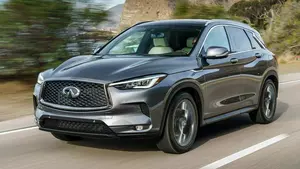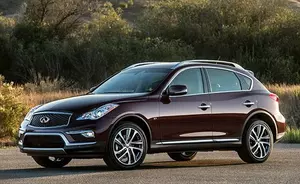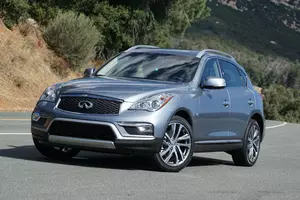
| Vehicle | Curb weight | Difference from world's smallest | Weight to power ratio | 0—60 mph acceleration ratio | Consumption ratio |
|---|---|---|---|---|---|
| 2.0 VC-Turbo |
1736 kg / 3828 lbs |
1311 kg (2891 lbs) heavier | 6 kg to 1 hp | 271 kg/s (598 lbs/s) | - |
| Vehicle | 2.0 VC-Turbo |
|---|---|
| Curb weight |
1736 kg / 3828 lbs |
| Difference from world's smallest | 1311 kg (1311 lbs) heavier |
| Weight to power ratio | 6 kg to 1 hp |
| 0—60 mph acceleration ratio | 271 kg/s (598 lbs/s) |
| Consumption ratio | - |

| Vehicle | Curb weight | Difference from world's smallest | Weight to power ratio | 0—60 mph acceleration ratio | Consumption ratio |
|---|---|---|---|---|---|
| 2.5 V6 |
1843 kg / 4064 lbs |
1418 kg (3127 lbs) heavier | 8 kg to 1 hp | 205 kg/s (452 lbs/s) |
172 kg/L (379 lbs/L) |
| 3.7 V6 |
1823 kg / 4020 lbs |
1398 kg (3083 lbs) heavier | 6 kg to 1 hp | 285 kg/s (628 lbs/s) | - |
| Vehicle | 2.5 V6 |
|---|---|
| Curb weight |
1843 kg / 4064 lbs |
| Difference from world's smallest | 1418 kg (1418 lbs) heavier |
| Weight to power ratio | 8 kg to 1 hp |
| 0—60 mph acceleration ratio | 205 kg/s (452 lbs/s) |
| Consumption ratio |
172 kg/L (379 lbs/L) |
| Vehicle | 3.7 V6 |
| Curb weight |
1823 kg / 4020 lbs |
| Difference from world's smallest | 1398 kg (1398 lbs) heavier |
| Weight to power ratio | 6 kg to 1 hp |
| 0—60 mph acceleration ratio | 285 kg/s (628 lbs/s) |
| Consumption ratio | - |

| Vehicle | Curb weight | Difference from world's smallest | Weight to power ratio | 0—60 mph acceleration ratio | Consumption ratio |
|---|---|---|---|---|---|
| 2.5 V6 |
1842 kg / 4062 lbs |
1417 kg (3125 lbs) heavier | 8 kg to 1 hp | 207 kg/s (456 lbs/s) |
174 kg/L (384 lbs/L) |
| 3.7 V6 |
1876 kg / 4137 lbs |
1451 kg (3200 lbs) heavier | 6 kg to 1 hp | 308 kg/s (679 lbs/s) |
166 kg/L (366 lbs/L) |
| 3.0d V6 |
1985 kg / 4377 lbs |
1560 kg (3440 lbs) heavier | 8 kg to 1 hp | 265 kg/s (584 lbs/s) |
234 kg/L (516 lbs/L) |
| Vehicle | 2.5 V6 |
|---|---|
| Curb weight |
1842 kg / 4062 lbs |
| Difference from world's smallest | 1417 kg (1417 lbs) heavier |
| Weight to power ratio | 8 kg to 1 hp |
| 0—60 mph acceleration ratio | 207 kg/s (456 lbs/s) |
| Consumption ratio |
174 kg/L (384 lbs/L) |
| Vehicle | 3.7 V6 |
| Curb weight |
1876 kg / 4137 lbs |
| Difference from world's smallest | 1451 kg (1451 lbs) heavier |
| Weight to power ratio | 6 kg to 1 hp |
| 0—60 mph acceleration ratio | 308 kg/s (679 lbs/s) |
| Consumption ratio |
166 kg/L (366 lbs/L) |
| Vehicle | 3.0d V6 |
| Curb weight |
1985 kg / 4377 lbs |
| Difference from world's smallest | 1560 kg (1560 lbs) heavier |
| Weight to power ratio | 8 kg to 1 hp |
| 0—60 mph acceleration ratio | 265 kg/s (584 lbs/s) |
| Consumption ratio |
234 kg/L (516 lbs/L) |